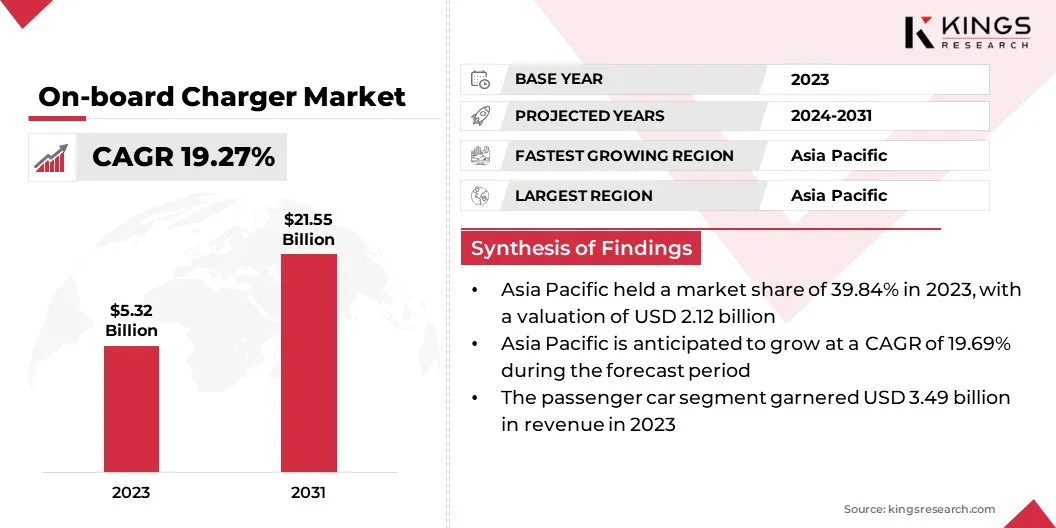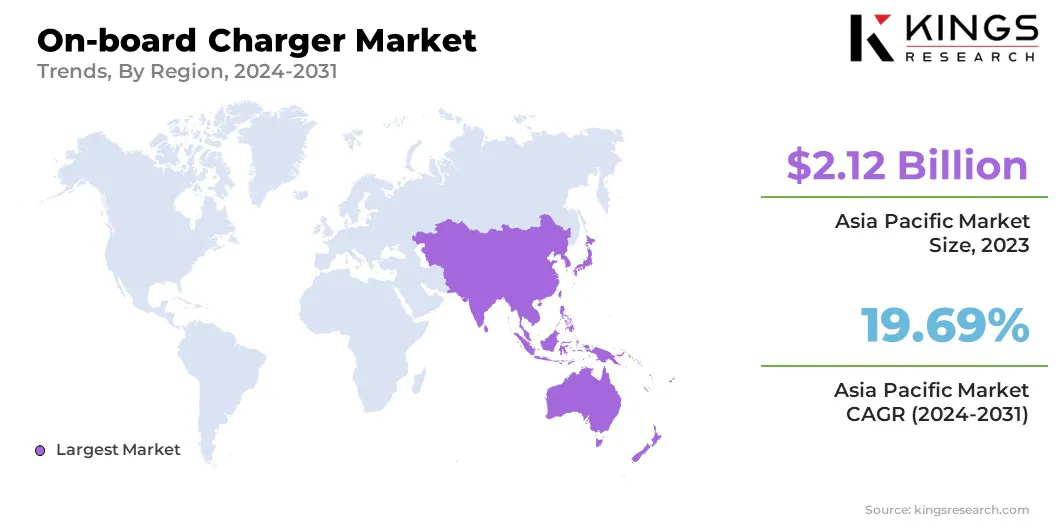Enquire Now
On-board Charger Market Size, Share, Growth & Industry Analysis, By Power Output (Less than 11 kW, 11 kW to 22 kW, More than 22 kW,), By Vehicle Type (Passenger Car, Buses, Vans, Others), By Propulsion Type, and Regional Analysis, 2024-2031
Pages: 170 | Base Year: 2023 | Release: April 2025 | Author: Sunanda G.
Key strategic points
The market focuses on systems integrated into electric and plug-in hybrid vehicles to convert AC from external power sources into DC for charging the vehicle’s battery. These chargers play a crucial role in energy conversion and battery management, supporting varying power levels, depending on vehicle specifications.
The market encompasses hardware design, control algorithms, thermal management, and compatibility with global grid standards. OBCs are used across passenger cars, light commercial vehicles, and electric buses, ensuring efficient charging performance.
The report highlights the primary market drivers, alongside significant trends, regulatory frameworks, and the competitive landscape, shaping the market expansion in the coming years.
The global on-board charger market size was valued at USD 5.32 billion in 2023 and is projected to grow from USD 6.28 billion in 2024 to USD 21.55 billion by 2031, exhibiting a CAGR of 19.27% during the forecast period.
The market is driven by the increasing deployment of AC charging infrastructure, which supports overnight and residential EV charging. Additionally, the integration of smart charging capabilities into on-board systems is enhancing grid responsiveness and energy efficiency, aligning with evolving EV architectures and accelerating market expansion.
Major companies operating in the on-board charger industry are Aptiv Global Operations Limited, BorgWarner Inc., Hyundai Mobis Co., Ltd., Eaton Corporation plc., Mitsubishi Electric Corporation, Infineon Technologies AG, Bel Power Solutions, Current Ways Inc., Toyota Industries Corporation, Innoelectric GmbH, Bosch, Lear Corporation, Delta Electronics, Murata Manufacturing Co., Ltd., and Sanken Electric Co., Ltd.
The market is registering significant growth, due to the rising volume of electric and plug-in hybrid vehicles entering global markets. Automakers are integrating advanced charging systems to ensure compatibility with varying regional power grids and charging speeds.
Increased investment in EV manufacturing, particularly across Asia and Europe, is accelerating the demand for efficient on-board charging solutions.

Market Driver
"Growing Deployment of AC Charging Infrastructure"
The widespread rollout of EV charging stations is influencing the growth of the on-board charger market. Residential, workplace, and public AC charging networks offer cost-effective and scalable solutions for EV owners, encouraging the adoption of OBCs capable of handling standard and high-voltage AC inputs.
With governments investing in nationwide charging infrastructure, vehicle manufacturers are prioritizing OBC efficiency and compatibility, thereby reinforcing their importance within the EV powertrain ecosystem.
Market Challenge
"Thermal Management in High-power On-board Chargers"
A significant challenge impacting the growth of the on-board charger market is effective thermal management, especially in high-power systems designed for fast charging. Excessive heat generation during operation can lead to reduced efficiency, component degradation, and safety concerns.
Companies are developing advanced cooling systems such as liquid-cooled housings and integrated thermal management modules. Manufacturers are also incorporating heat-resistant materials and compact designs that enhance heat dissipation.
These innovations are helping to ensure performance stability, extend product lifespan, and maintain safety standards, thereby supporting broader adoption across EV platforms.
Market Trend
"Integration of Smart Charging Capabilities"
The on-board charger market is being driven by the integration of smart charging features that support two-way communication between the vehicle and the grid. These chargers allow real-time energy management, dynamic load balancing, and scheduled charging to align with energy pricing models.
Such functionalities are becoming essential in regions advancing toward smart grid adoption. Automakers are aligning their OBC technology with these developments to offer added value through energy optimization and grid reliability.
|
Segmentation |
Details |
|
By Power Output |
Less than 11 kW, 11 kW to 22 kW, More than 22 kW |
|
By Vehicle Type |
Passenger Car, Buses, Vans, Medium & Heavy Duty Vehicles, Boats, Others |
|
By Propulsion Type |
Battery Electric Vehicle (BEV), Plug-in Hybrid Electric Vehicle (PHEV) |
|
By Region |
North America: U.S., Canada, Mexico |
|
Europe: France, UK, Spain, Germany, Italy, Russia, Rest of Europe |
|
|
Asia-Pacific: China, Japan, India, Australia, ASEAN, South Korea, Rest of Asia-Pacific |
|
|
Middle East & Africa: Turkey, UAE, Saudi Arabia, South Africa, Rest of Middle East & Africa |
|
|
South America: Brazil, Argentina, Rest of South America |
Market Segmentation:
Based on region, the market has been classified into North America, Europe, Asia Pacific, Middle East & Africa, and Latin America.

Asia Pacific on-board charger market share stood at around 39.84% in 2023, with a valuation of USD 2.12 billion. The transition toward electric mobility for city bus services, ride-hailing fleets, and last-mile delivery vehicles in urban corridors is creating high-volume demand for OBC-equipped vehicles.
These fleet segments primarily utilize overnight AC charging at depots or charging hubs, where the role of onboard chargers is critical for operational continuity. This sustained demand across public and commercial applications is driving the market in Asia Pacific.
Furthermore, EV manufacturers across Asia Pacific are engineering platforms tailored to regional infrastructure capabilities, with a focus on compatibility with standard AC charging. This emphasis on efficient and compact OBC systems is enhancing the cost-performance ratio of EVs in the region, directly contributing to the growth of the market.
The on-board charger industry in Europe is poised for significant growth at a robust CAGR of 19.45% over the forecast period. Corporate fleet operators in Europe are increasingly transitioning to EVs in response to ESG targets and tax incentives tied to emissions reductions.
Company vehicles are often charged at offices or homes using AC power sources, placing on-board chargers at the center of the charging process. This institutional transition is scaling up the demand for OBC-equipped EVs, advancing the growth of the market in the region.
Moreover, the adoption of home energy systems that combine solar panels, battery storage, and EV charging is gaining traction in Europe. These setups typically rely on AC charging via smart on-board chargers capable of syncing with renewable inputs and optimizing charging schedules.
Market players are increasingly focusing on the development of advanced on-board chargers that align with the evolving architecture and performance demands of specific EV platforms.
By engineering compact, multi-functional systems tailored to off-highway vehicles and high-voltage battery systems, companies are strengthening their product portfolios while supporting OEM requirements.
This targeted approach is enabling more efficient vehicle integration, reducing design complexity, and improving operational reliability. These factors are directly contributing to the growth of the market across specialized EV segments.
Recent Developments (Product Launch)
Frequently Asked Questions